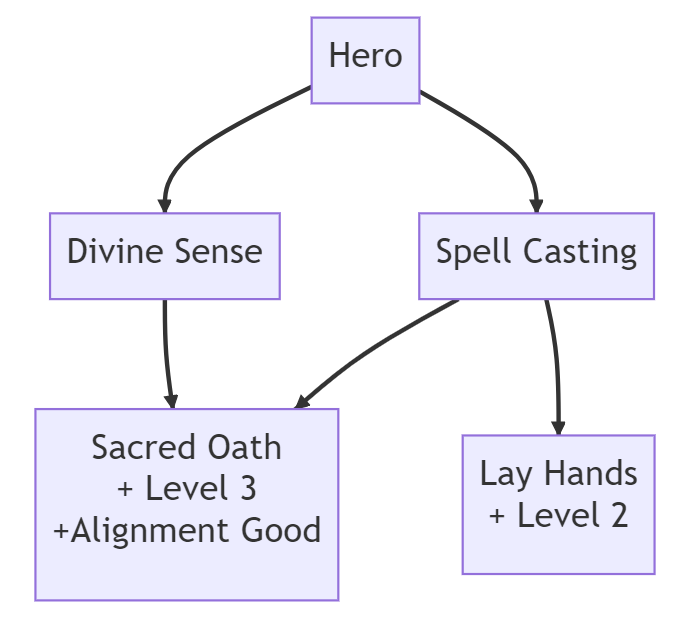Day 2: Skill Tree Builder and Unit Testing
Today, we implemented a SkillTreeBuilder class that allows for construction of an ISkillTree. While implementing this, we discovered a few flaws in our interfaces which we corrected. Additionally, we wrote unit tests to validate that the SkillTreeBuilder we implemented was correct.
Table of contents
Today’s Tasks
-
Implement Skill Tree Logic -
Unit Test Skill Tree Logic - Define ScriptableObjects to test SkillTree
Redefining Skill Tree Interfaces
As we began to work with the interfaces we had previously defined, it became clear that they would not meet our requirements.
Our ISkillTree<T> interface, needed a lookup for specific nodes within the tree. To accommodate this, we added a GetNode method:
public interface ISkillTree<T> where T : ISkill
{
/// The root node of this skill tree
public ISkillNode<T> Root { get; }
/// Retrieves the <see cref="ISkillNode{T}"/> associated with the specified
/// <paramref name="skill"/>. Throws an exception if the specified <paramref
/// name="skill"/> is not in this <see cref="ISkillTree{T}"/>.
public ISkillNode<T> GetNode(T skill);
}
We also realized the ISkilledEntity<T> interface should utilize a HashSet<T> to represent the skills the entity has acquired rather than the specific nodes:
/// An <see cref="ISkilledEntity{T}"/> represents an entity that can acquire
/// skills of the specified type.
public interface ISkilledEntity<T> where T : ISkill
{
/// A HashSet of skills that this entity has acquired
public HashSet<T> Skills { get; }
}
Lastly, we extracted ISkillRequirement from within the ISkillNode making it a top level interface:
/// A Requirement acts as a predicate on a character.
public interface IRequirement<T> where T : ISkill
{
/// Checks if the specified <paramref name="entity"/> meets this
/// requirement.
public bool MeetsRequirement(ISkilledEntity<T> entity);
}
Implementing a SkillTreeBuilder
With these interfaces defined, we began to layout a SkillTreeBuilder API that would allow us to construct a simple skill tree. Below is the public API that we defined:
public class SkillTreeBuilder<T> where T : ISkill
{
/// Instantiates an instance specifying the root node of the resulting <see cref="ISkillTree{T}"/>
public SkillTreeBuilder(T root);
/// Adds the specified <paramref name="parent"/> to <paramref name="child"/> requirement
/// to the resulting <see cref="ISkillTree{T}"/>.
public SkillTreeBuilder<T> AddSkill(T parent, T child);
}
/// Adds the specified <paramref name="requirement"/> to the <paramref name="skill"/>
public SkillTreeBuilder<T> AddRequirement(T skill, IRequirement<T> requirement);
/// Builds and returns a <see cref="ISkillTree{T}"/> as specified by this builder. Future
/// modifications to the builder do not affect the returned tree.
public ISkillTree<T> Build();
}
Using this set of methods, we can construct an ISkillTree in the following way:
SkillTreeBuilder<MySkillTree> builder = new(Hero);
builder
.AddSkill(Hero, SpellCasting)
.AddSkill(Hero, DivineSense)
.AddSkill(SpellCasting, LayOnHands)
.AddRequirement(LayHands, new LevelRequirement(2))
.AddSkill(DivineSense, SacredOath)
.AddSkill(SpellCasting, SacredOath)
.AddRequirement(SacredOath, new LevelRequirement(3))
.AddRequirement(SacredOath, new AlignmentRequirement(Good));
ISkillTree<MySkill> PaladinTree = builder.Build();

The implementation of the SkillTreeBuilder uses a dictionary to construct a directed graph. Upon calling the Build method, a deep copy of that graph is created and returned. The full implementation from today is available here: SkillTreeBuilder.cs
Unit Tests
After defining the API that we would use, we developed a set of unit tests to ensure that we could construct the skill tree described above. To help with this, we utilized the Moq library which allows us to create a mocked ISkilledEntity that we can validate the requirements against.
We first constructed the skill tree using the builder then, wrote a unit test for each node in which we assert each of the specified properties. For example, the SimpleTreeTestSpellCastingNode test is shown below:
[Fact]
public void SimpleTreeTestSpellCastingNode()
{
// Get the SpellCasting node
ISkillNode<MockSkill> skillNode = SimpleTree.GetNode(SpellCasting);
// Check that the node retrieved has the SpellCasting skill
Assert.Equal(SpellCasting, skillNode.Skill);
// It should have two children
Assert.Equal(2, skillNode.Children.Count());
// The SacredOath and LayOnHands skills are in the children
Assert.Contains(SimpleTree.GetNode(SacredOath), skillNode.Children);
Assert.Contains(SimpleTree.GetNode(LayOnHands), skillNode.Children);
// Setup a Mock ISkilledEntity
Mock<ISkilledEntity<MockSkill>> mockEntity = new();
// Specify that the entity has no skills
mockEntity.Setup(x => x.Skills).Returns(new HashSet<MockSkill>());
// If the entity has no skills, it should not pass the CheckRequirements
Assert.False(skillNode.CheckRequirements(mockEntity.Object));
// Specify that the entity should now have the Hero skill
mockEntity.Setup(x => x.Skills).Returns(new HashSet<MockSkill> { Hero });
// The entity should pass the CheckRequirements now
Assert.True(skillNode.CheckRequirements(mockEntity.Object));
}
A similar process was followed for each of the other nodes. You can find the full set of tests from today here: SkillTreeBuilderTest
With this, we should be able to construct a variety of interesting skill trees within a project. Unfortunately, we ran out of time and didn’t make it to our 3rd goal Define ScripatbleObjects to test SkillTree. So, we have left that for tomorrow. Will the library we came up with be enough for a skill tree system? We’ll find out soon enough! See you tomorrow!
Join the Discussion
Before commenting, you will need to authorize giscus. Alternatively, you can add a comment directly on the GitHub Discussion Board.